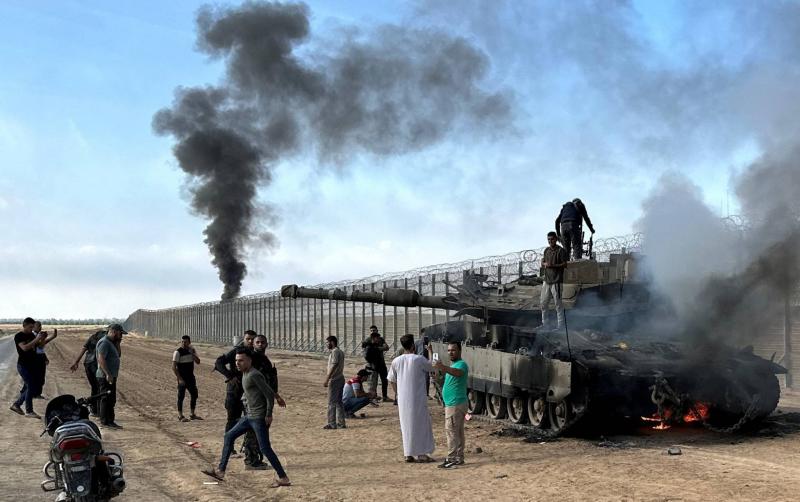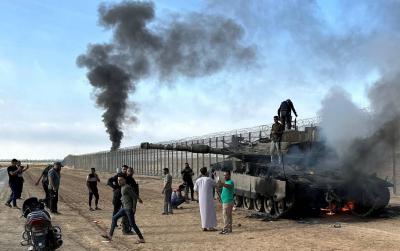Palestinian sources close to the leadership of "Izz ad-Din al-Qassam Brigades," the armed wing of Hamas, revealed new details about the "Al-Aqsa Flood" attack carried out on October 7th, which changed the region's landscape and marked the end of one era while opening another with endless possibilities. The surprise attack by Hamas resulted in the death of over 1,200 Israelis and the abduction of more than 200 others from settlements, kibbutzim, and military sites around the Gaza envelope. In response, Israel claims to have killed many of the attackers (at least 1,500 Hamas members). Additionally, Israel has killed over 23,000 Palestinians in its ongoing retaliatory war on Gaza.
The Palestinian sources told "Asharq Al-Awsat" that the flood began with just 70 fighters who launched a surprise attack from several areas along the border of the Gaza Strip from north to south. These were the individuals who breached the Israeli border at the initial moments by detonating explosives designed specifically to create openings in a thick wall after identifying its weak points, and by using paragliders and parachutes to drop fighters behind, above, and around Israeli positions.
The sources said these selected fighters came from various parts of the Gaza Strip and among hundreds from the "elite unit," having undergone intensive training over several years, with periodic assessments to determine their abilities and improve their combat skills. They emphasized that the plan to breach settlements around Gaza is not new, having been conceived and prepared before the 2014 war, and was subsequently frozen until efforts resumed a year later. Following the "Sword of al-Quds" battle in 2021, the military wing of Hamas decided to prepare for its implementation when the conditions were right.
Shortly after starting training, which seemed inexplicable to the participants, the most distinguished elite members chosen for the operation took a special oath before their leaders promising not to divulge any secrets about their training or any plans related to it, despite not knowing a clear and immediate attack plan was in place, as they only received specialized training for breaching settlements.
Many battalion leaders in the Gaza Strip were unaware of any details or even the intention of an imminent attack, while some were informed of limited information regarding their missions. This was part of a security plan designed to prevent any information leaks that could reach Israeli intelligence, which later admitted its failure to prevent the events of October 7th.
According to the same sources, the decision to execute the attack and its timing was made by only five individuals: Yahya Sinwar, Hamas leader in Gaza; Mohammed Deif, commander of the al-Qassam Brigades; one of his key aides and a top Israeli target, Mohammed Sinwar (Yahya’s brother); Hamas leader Rouhi Mushtaha, a close associate of Sinwar; and Ayman Nofal, a close associate of Deif and former head of al-Qassam’s intelligence, who was killed by Israel during the current war.
The sources reported that those responsible for preparing the operation later informed the leaders of the al-Qassam Brigades about the arrangements and the attack plan, but not its timing, and they were notified three days prior for the final preparations. They then met with the brigade leaders and assigned each leader specific tasks without specifying a "zero point." Brigade leaders prepared their selected forces for the mission, while Ayman Sayyam, commander of the rocket unit for Gaza (also killed during this war), received specific instructions to prepare for launching hundreds of rockets coinciding with the start of the attack.
The sources explained how October 7 was chosen, as field reports from observation units confirmed complete stillness at the border. The five officials decided on Friday that the best time to strike would be Saturday morning (the official holiday in Israel), and as midnight approached (the eve of October 7), orders were given to prepare. Field commanders and "elite forces" fighters received instructions and began moving until dawn when the operation commenced.
The secrecy surrounding the operation extended to Hamas’ political leaders as well; sources stated that Hamas leaders inside and outside the strip were briefed hours before the operation and were instructed to go into complete hiding, following security measures taken during emergencies.
The sources added that senior leaders of the movement, including its chief Ismail Haniyeh and his deputy Saleh al-Arouri, were made aware of a plan for an exceptional attack without precise details or the timing, receiving updates just hours before, like the rest.
They emphasized that the primary goal of the plan was to execute a "significant qualitative attack" and capture a group of Israeli soldiers, but surprises made the attack broader than intended. Fighters were surprised at the ease with which they breached Israeli defense lines, leading to the immediate deaths and captures of many soldiers.
An hour and a half into the primary attack, a decision was made to mobilize the remaining members of the elite units in al-Qassam, who received messages to gather at different points and move as support forces for those inside the settlements. Later, the military wing coordinator of al-Qassam notified other armed factions that they could participate in the operation, assigning specific tasks to each faction, and the attack expanded as hundreds of armed fighters and civilians, even journalists, entered the settlements after the collapse of Israeli forces.
The sources confirmed that after capturing dozens of Israelis amidst significant chaos, al-Qassam's leadership instructed the fighters in the settlements to occupy Israeli forces as much as possible, using this as an opportunity to focus on gathering and hiding the captives.
Hamas, along with Palestinian factions and groups, successfully transported around 240 captives, including Israelis and non-Israelis (like Thai workers), into Gaza. Currently, about 136 remain after earlier prisoner swaps. The Israeli army later found the bodies of some captives and transferred them to Israel during ongoing ground operations in the strip.




